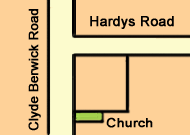Wesleyan Methodist Church, Clyde North (1864)
Before the erection of this building it is mentioned in the Clyde North School History Book that a Wesleyan Methodist Sunday School was operating in 1859. During the week it was used as a primary school. Embling Hardy was a Wesleyan lay preacher in Britain before coming to Australia. For many years he was the Sunday School Superintendent in Clyde.
William Sykes (1820-1887) and Embling Hardy (1830-1886) are two of the known Methodist Lay men who preached in that church.
The evening "Tea Meetings" were a highlight of the Church's activities and were very popular.
William Sykes, bought land in Clyde in 1854 and moved his family from Brighton to live there. His life was deeply impacted by the spiritual life of the Brighton congregation. This was evidenced by his concern for local areas by visiting people and congregations in Lyndhurst, Dandenong, Keysborough and even as far as Monomeith (1860).
In 1863, outspoken Yorkshire evangelist and temperance campaigner, Matthew Burnett visited Berwick and his itinerary included a stop over in Clyde. He was the guest of Alexander Patterson, an elder of the Cranbourne Presbyterian Church. The Burnett meetings had a good impact on Clyde enriching lives for years to come.
It is most likely that it was in this "hall" that Alexander Patterson gave his lecture about meteorites ion February 15, 1865.
It was reported that in 1877, a “Band of Hope” which supported the temperance movement was meeting in the Temperance Hall. (most likely a reference to the Wesleyan Church building)
In Victoria 1841, with 650 members (5.5% of the population), the Wesleyan Methodist church swelled its numbers to 97,115 in 1881, representing 11.2% of the state. It was characterised by sincere practical faith concerned for the physical and spiritual welfare of society.
By the turn of the century its hand-made bricks were crumbling and the building was falling into disrepair. In 1887-88 the railway line built from Dandenong through the Koo Wee Rup Swamp by-passed Clyde (North) and another settlement formed around the new Clyde railway siding. This would not encourage repairs to the old church. The pulpit and its rail and 14 seats were repaired, varnished and relocated in the new Clyde Methodist Church in 1909. In the 1900’s the Wesleyan Methodist Church didn’t maintain its growth as previous.
The catalyst for renewal of the movement throughout Australia after WW2, came in the person of another Ridgway. Kingsley Ridgway, born in Lang-Lang, the grandson of William Ridgway, son of Anthony Ridgway.
Family Historians can you help with more information about the Wesleyan Methodist Church?
Newspaper Articles
![]()
It is the unlawful behaviour of a Mr Churchill, resulting in a police report which acknowledges the existence of the school in 1867.
| Clyde Band of Hope supports Mr Gibb, a parliamentary candidate. A meeting of the friends and supporters of Mr James Gibb late member for Mornington was held (our Cranbourne correspondent reports) at the Band of Hope Clyde on Monday evening. A unanimous vote was recorded approving of the able manner in which he had represented the constituency and a large and influential committee formed for the purpose of securing his return.
|
Police Report 5 August 1867
CRANBOURNE.-On Saturday (before Messrs. Adams, chairman, J. Wedge, and Patterson, J. P.'s), Mr. Cadd and the trustees of the Wesleyan school at the Clyde sued Mr. Churchill for illegally detaining stools, forms, &c., the property of the trustees. It appeared from the evidence that Churchill had sold the ground on which the school was built to the trustees, for the sum of one shilling, but had afterwards opened the door with a false key, and taken the things complained of. Mrs. Churchill said she had been served with a summons, but though her husband was in the house after the service she had never told him, and had taken the things back. The Bench said the case might have been made one of felony, but as the summons had been worded "detaining," and as the things had been taken back, they would dismiss the case, with 5s. costs against the defendant.
|
Sources
1. A Ridgway Family Historian
2. Eric Thomas: History of the Clyde Methodist Church
3. History of Clyde North School
4. Perce Hardy Remembers
5. Thomas Patterson – Letter to Editor of The Argus
6. The Early Story of the Wesleyan Methodist Church –Blamires & Smith 1886
7. A Hardy Family historian.
8. Early Evangelical Revivals, Ch 11, Matthew Burnett in Victoria , by Robert Evans 2007
9. Wesleyan Methodist Church-Wikipedia
10. Thomas Patterson, son of Alexander Patterson, a Cranbourne Presbyterian elder, lived at St Germains.
11 The Argus, 21 April 1923 - article about Patterson and meteorite.

